Blog •
Last updated on Feb 02, 2024
How to Create a Writing Portfolio That Wins Clients [+Examples]
About the author
Reedsy's editorial team is a diverse group of industry experts devoted to helping authors write and publish beautiful books.
More about the Reedsy Editorial Team →Linnea Gradin
The editor-in-chief of the Reedsy Freelancer blog, Linnea is a writer and marketer with a degree from the University of Cambridge. Her focus is to provide aspiring editors and book designers with the resources to further their careers.
View profile →Whether you’re a ghostwriter, journalist, freelance writer, or author, your writing portfolio is not only a summary of your previous work, it’s also your resume, business card, and shop front. With that in mind, if your aim is to make writing into a career, you should aim to compile a writing portfolio that properly represents your expertise and instills potential clients with confidence and a little bit of awe.
This post will guide you through collecting and curating your portfolio samples, as well as advise you on how to use professional-grade web design to make them stand out in 7 steps. For some inspiration, we’ve also included example portfolios that effectively demonstrate a writer’s abilities.
1. Understand the market and find your niche
Before you kickstart your freelance writing career, it’s worth understanding who you’re targeting with your portfolio. Just as a tailor would measure their client before assembling a suit, portfolios are most effective when tailored to a specific audience. By understanding what your intended clients are looking for in a freelancer, you can start to position yourself as the solution to their problems — and in doing so, win the types of gigs you want to win. So keep in mind that as much as the portfolio is about you, it is also about the client.
Choose your market
Nobody really lands a job as a generic ‘writer’. If you don’t already know what type of writer you are (or would like to become), here are some common fields to help funnel your thinking down to specifics:
- Copywriting and content marketing;
- Ghostwriting;
- Journalism;
- Essay and opinion writing;
- Technical writing.
Ask yourself what you enjoy writing about, and also, whether there is demand for this sort of work. Thinking in terms of industries can help here too: a ghostwriter may find themselves specializing in fields ranging from finance, to news and journalism, health and wellness, parenting, book publishing, or romance fiction, to name a few. Each broad channel of freelance writing will have a narrow stream that you can home in on based on your skills and interests.
Once you have an idea of the market you want to work in, get familiar with current trends and see what other experts in that field are producing. This is not about being a copycat, but you need to be able to show your future clients that you are well acquainted with the topography of the field.
Aligning your likes, experience, and knowledge of certain industries in this way can help you set concrete goals for your portfolio curation, and distill what message you want to send to attract the right clients.
By first understanding what clients in your preferred market want to see in a freelancer, you can then set to work finding the work in your back catalog that best presents you as their dream hire.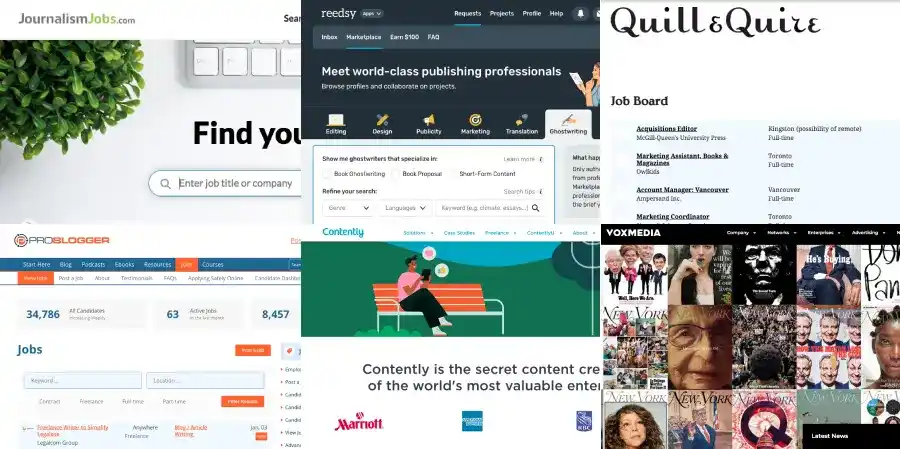
Identify your ideal clients
As we teased at the end of the last section, once you’ve chosen your market you’ll want to decide who to target specifically. Ideally, you want to be the unique person who can solve their specific problem. Editors are inundated with writing packets all the time, so your portfolio needs to communicate that you can do the work that’s needed and you have evidence of prior success.
If you’re a ghostwriter who wants to specializing in romance novels, for instance, you might shape your portfolio to emphasize experience in:
- Novel writing;
- Writing for a female adult audience; and
- Working with or on successful titles in the romance genre.
Whereas if you’re looking for copywriting and content marketing work in real estate, your focus will probably be around:
- Blog posts targeted at high volume search terms
- Reader magnets and lead building
- Online ad copy
Just as the romance writer will always trump a general writer applying for a romance role, so too will a copywriter specializing in yoga and nutrition over a finance copywriter going for a health and wellness gig. Whether you choose to work in an industry where your interests lie or follow where the work is, your portfolio needs to show what the client expects. 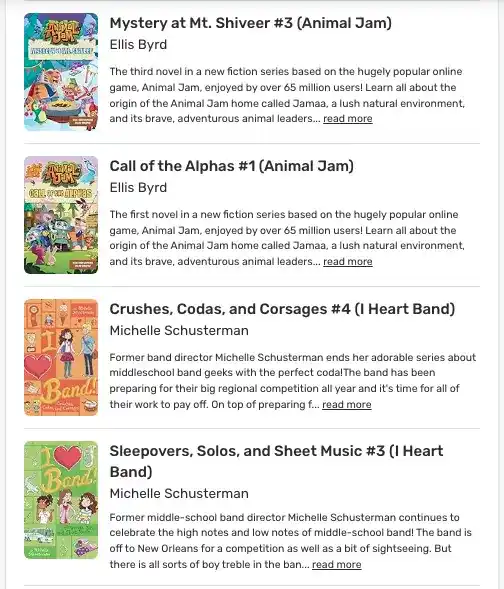
Take ghostwriter Michelle Schusterman’s portfolio, for instance. At a quick glance, you can tell she is a fiction ghostwriter who specializes in children's fiction (specifically middle-grade). When potential clients browse her portfolio on Reedsy, they know what kind of writer she is, and the style they can expect from her.
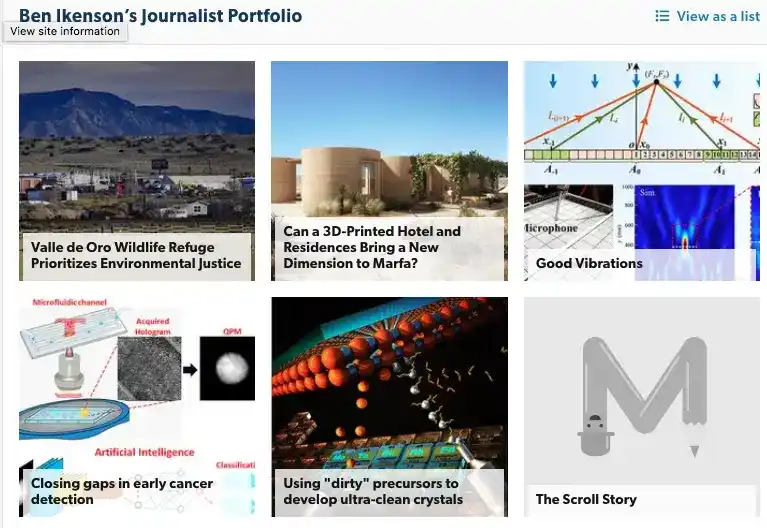
On the other end of the spectrum, looking at Ben Ikenson’s portfolio, there’s no mistaking that he is a science writer.

JOIN REEDSY
Find exciting new projects
We connect publishing professionals with our community of 1,500,000 authors.
2. Select relevant writing samples
With your audience in mind, it’s time to pick your writing portfolio examples. A rule to remember is to only include the best and most relevant work, not everything you’ve ever written. 10-30 pieces will suffice if you’ve done quite a bit of writing, but three-to-five quality articles can be enough if you’re just starting out.
Let’s look at how to choose what to include.
Curate your examples
For editors and clients, your portfolio answers the question of if you can write, speak to a reader, research, and present yourself in the manner your audience expects. More than that, if they have to wade through a complete chronology of your writing and outdated examples to find your relevant work, you’ll not only be wasting their time, but also doing your own name and brand a disservice.
Only include the specific types of content you’ll be working on when submitting applications. When it comes to your portfolio, you're directing people with a specific action in mind: to hire you.
 Simon Denyer’s portfolio with Authory is a good example of striking a balance between specificity and depth. He’s covered country specific-writing across most of Asia, on topics from climate to wildlife pieces, and even the Olympics; yet although there’s variety, a theme runs through his work.
Simon Denyer’s portfolio with Authory is a good example of striking a balance between specificity and depth. He’s covered country specific-writing across most of Asia, on topics from climate to wildlife pieces, and even the Olympics; yet although there’s variety, a theme runs through his work.
 Likewise, Nida Khan’s portfolio with MuckRack shows the breadth of topics she’s covered as an independent journalist, and also the different platforms she’s written for. But like Denyer’s portfolio, her varied topic coverage is specific in what she writes about.
Likewise, Nida Khan’s portfolio with MuckRack shows the breadth of topics she’s covered as an independent journalist, and also the different platforms she’s written for. But like Denyer’s portfolio, her varied topic coverage is specific in what she writes about.
Divide your portfolio into relevant sections
Another reason Denyer’s portfolio is so effective is because he has divided it into easy-to-navigate sections that give an immediate overview of what he’s offering. We can see where and what he’s written at a glance. Experienced and junior writers alike can use this technique, as it helps guide readers to where they will find your most relevant work.

When entering Jennifer Fernandez’s portfolio, the first thing you see is how she has decided to divide her writing into three categories: design, travel, and lifestyle. It doesn’t hurt that the portfolio is stunning too.
Following Jennifer’s design, dividing your work into relevant fields also gives you an idea of how to best group your writing samples. Topical divisions (i.e. “Food & Drink”, “Travel”) might be suitable for some, while others find it more beneficial to categorize by types of writing, or, in some cases, chronology.
Pad your portfolio with spec pieces
If you’re at the start of your career, and have chosen a niche to write in but only have a few relevant pieces, or none at all, you can always fill out your portfolio with some spec pieces. That’s any piece of writing on a topic of your choosing that demonstrates your skill, even though it has not been commissioned or published by anyone (yet).
To be clear, spec pieces can be used in your portfolio as an example of your abilities, but should be indicated clearly that they are, in fact, unpublished or practice material. A single longer piece, or two smaller ones, will suffice if your portfolio is thin — but again, note to clients the truth of the writing and don’t try to pass them off as published works.
Why you decided to write these practice pieces, and for who you wrote them, will be far more interesting for a potential client anyway. Explaining the examples in this manner will show your ability to research the market, choose suitable topics and keywords, and write content for a specific audience.
3. Pick a host platform
Now that you know what to put into your portfolio, you have to decide where to house it. You’ve got two broad options when it comes to this: build a website yourself, or choose from a myriad of portfolio hosting services.
Create your own website
Building your own, custom-made website option gives the most creative control over the presentation of your writing portfolio. While it may sound daunting, platforms like Squarespace, Wix, and WordPress make it fairly easy to design basic but effective portfolios with templates and click-and-drag features that anyone can master. And if you’re focusing on creating a brand for your writing, a custom URL will always send a stronger message than a slug extension from a host URL. It’s clear from Phoebe Amoroso’s Wordpress-powered website what she is about: travel, food, and journalism.
It’s clear from Phoebe Amoroso’s Wordpress-powered website what she is about: travel, food, and journalism.
Another option is to consider having a boutique website made for you by a website designer. Just look at the work website designer Matthew Prodger has created for writers below. His work for author Sharon Janet Hague is clear and professional. The website is easy to navigate across multiple platforms, looking just as fantastic on a phone as it does on desktop or tablet. Handy to know, considering your potential employer may be viewing your profile on the go.
His work for author Sharon Janet Hague is clear and professional. The website is easy to navigate across multiple platforms, looking just as fantastic on a phone as it does on desktop or tablet. Handy to know, considering your potential employer may be viewing your profile on the go.
Choose a portfolio host
If designing a website feels like extra work for you, there are many trusted portfolio hosts to choose from. Think of these sites as LinkedIn accounts made specifically for writers and other creatives. All you need to do is set up an account and fill in the information that they ask of you, including links to your published work.
Some popular options include:
- MuckRack, a popular platform for journalists and PR professionals;
- Contently, a useful site for content writers;
- Format, a visual-based service that makes sleek portfolios;
- JournoPortfolio, a newer website for every kind of freelance writer;
- Clippings.me, which provides a clean cut design for all kinds of writers.
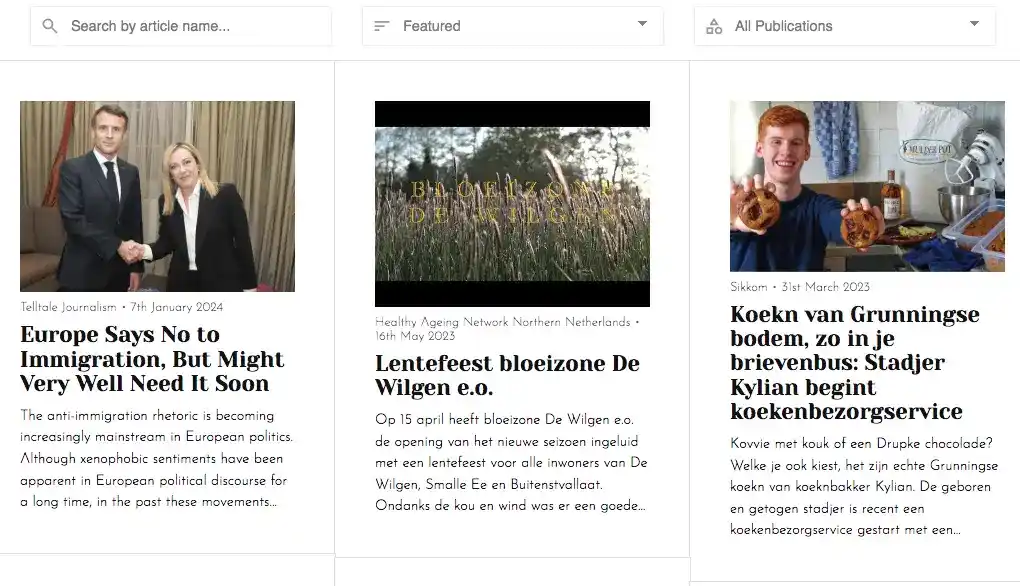 Robin van Gammeren’s professional portfolio on JournoPortfolio allows visitors to browse by publication, category, and keyword, making it easy for her clients or potential future employees to find the information they’re looking for and get an overview of her writing repertoire.
Robin van Gammeren’s professional portfolio on JournoPortfolio allows visitors to browse by publication, category, and keyword, making it easy for her clients or potential future employees to find the information they’re looking for and get an overview of her writing repertoire. The same goes for Jonathan O’Callaghan’s portfolio with Authory. Slick and direct, clients know what they get when clicking onto his profile. His science-based writing reaches for the stars and lands among them.
The same goes for Jonathan O’Callaghan’s portfolio with Authory. Slick and direct, clients know what they get when clicking onto his profile. His science-based writing reaches for the stars and lands among them.
If you are a ghostwriter and meet our selection criteria, you can also apply to freelance via Reedsy, and set up a portfolio on your personalized profile, which clients can browse on our marketplace. Check out the criteria here.
 Kendall Davis is a ghostwriter with Reedsy, and when clients view her portfolio, they see the extensive work she’s done in writing, her past clients, and with our expanded overview section, they also get a snapshot of who she is.
Kendall Davis is a ghostwriter with Reedsy, and when clients view her portfolio, they see the extensive work she’s done in writing, her past clients, and with our expanded overview section, they also get a snapshot of who she is.
The good news? All of these portfolio sites are either free or offer a free trial period to test their features. However, a free version of an account will often limit the number of articles you can display. If you want to display more work, you’ll have to pay for a bigger plan.
4. Nail the design and layout
Having assembled all your writing ingredients, and decided upon where to host your digital portfolio, let’s bake this writerly cake!
Make it reader friendly
The main benefit of a host website is that this simple step of uploading will leave you with a professional-looking portfolio from the get-go. Basic plans offer near-to-no customization of your page, but if you decide to move onto paid plans, then customization like your own website will also be available.
Similarly, for custom websites, simplicity is key. The three main components your portfolio needs are a landing page for a brief introduction, a page to showcase your writing, and a contact page that provides your email address or a contact form.
Following that, scrolling and clicking should be kept to a minimum. While the tips following are more aesthetic in nature, the easier it is for your clients to navigate your writing portfolio, the better. Overwhelm with options and a rabbit’s warren of clicks will result in them feeling lost; most likely losing you the opportunity and gig.
Choose simple color schemes and themes
While you may not specifically focus on branding with your portfolio, you are a brand in name. So when thinking in terms of design for your website, simple color schemes and themes are your best friend. They’re powerful and clear, and allow the focus to be on your work — not the funky neon background paired with the typewriter font menu. When in doubt, go for themes which give plenty of space for your work to be the highlight.
Most host-based portfolio sites have taken care of the design decisions for you to make this easier. Just take Mayson Taylor’s portfolio below as an example. Made with JournoPortfolio, her profile resembles a newspaper column and showcases her varied entertainment themed work in a simple, but elegant, way. The simple yet eye-catching design shines a spotlight on her work without detracting from the information she wants to share.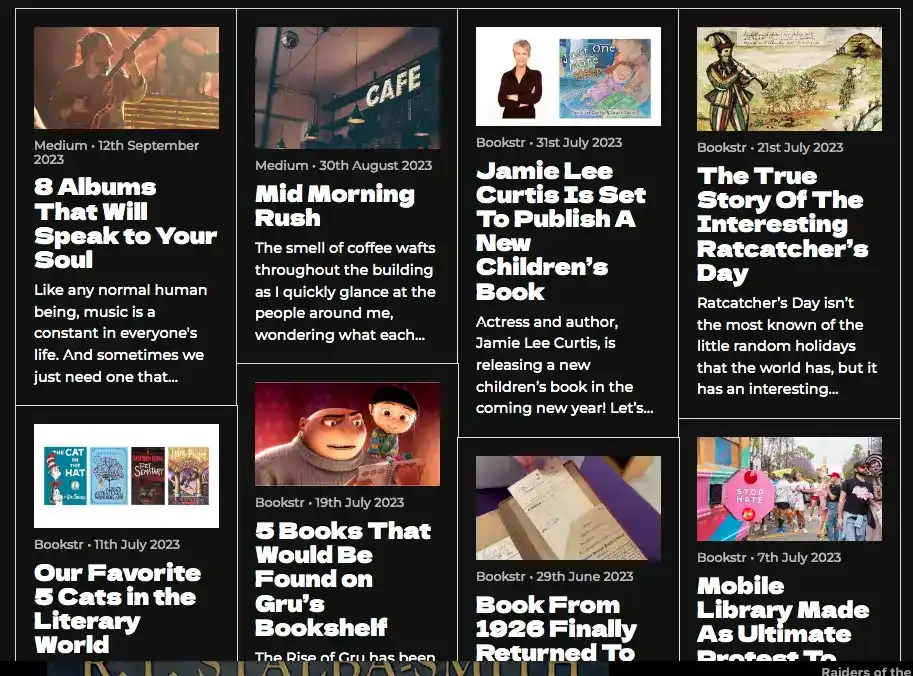
Go for sans serif fonts
Throughout this guide you’ll have noticed that a lot of the host websites predominantly use sans serif fonts, or serif font headlines with a sans serif body text. For those of you who are a bit rusty on the fonts lingo, that’s because sans serif fonts — fonts with no extra embellishments or “feet” dangling off the ends of the letters — reduce eye strain when browsing. While there was a period when Times New Roman reigned supreme, too much of a good thing is something our brain can find overwhelming.
So, to keep your already slick portfolio looking squeaky clean, pairing bolded sans serif headlines with sans serif body texts will have you looking sharp, and reader friendly. If you definitely want to use serif fonts too, restrict it to the elements of your portfolio that are purely there for design and don't contain any key information that you want people to be able to process smoothly.
Use white space
With your portfolio, a good rule of thumb for everything is that less is more, especially with design. The more the brain has to register, the less effective your writing portfolio will be. This is why utilizing white space (the areas without text or image) is so powerful. With nothing to detract, or distract, the reader will be focused on your work.
Just look at NYT software engineer and part-time writer Nozlee Samadzadeh’s portfolio below. She lets her work speak for itself with this minimalist design. But also, many of the other portfolios we’ve featured have used their space wisely to focus the eyes on the writing.
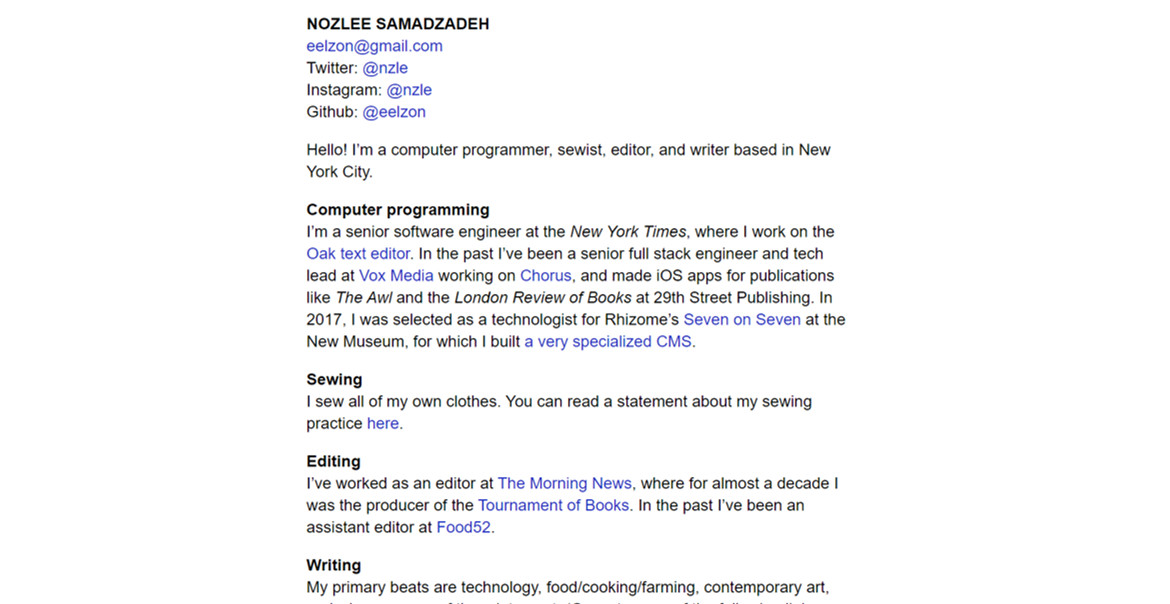 The same can be said for host sites and their use of white space.
The same can be said for host sites and their use of white space.
Sharon Hurley Hall’s portfolio with Contently is straight to the point, showcasing the topics she fights, and writes, for. More than that, Contently and other host sites all have professional designs which make writers’ portfolios pop from the first piece and upload.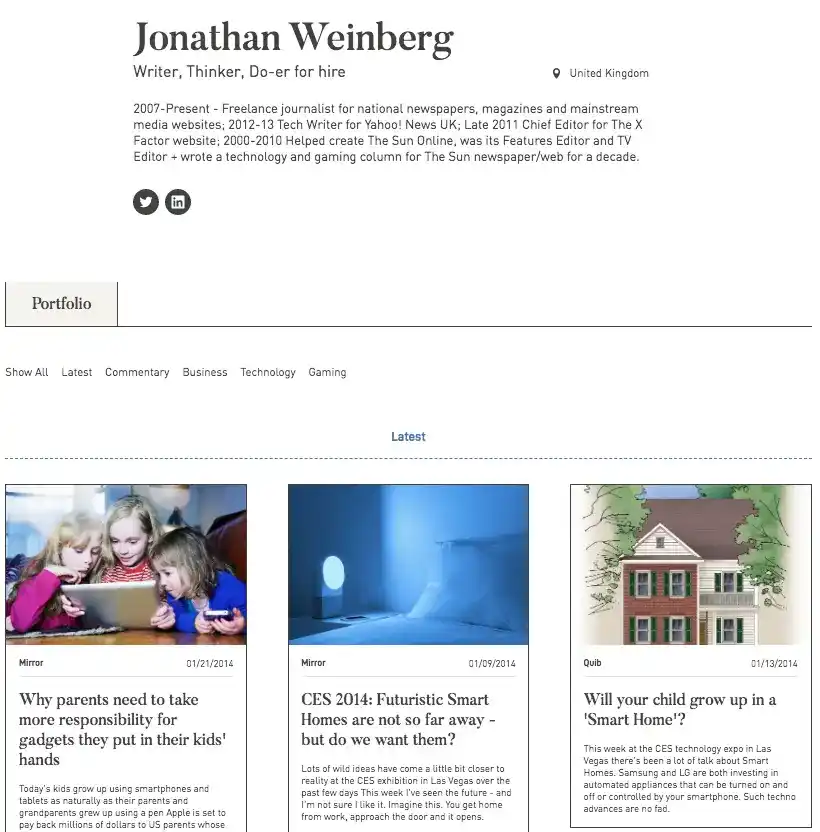 Again, Jonathan Weinberg’s portfolio for Clippings.me does what it’s meant to do in a professional and easy-reading manner.
Again, Jonathan Weinberg’s portfolio for Clippings.me does what it’s meant to do in a professional and easy-reading manner.  Just to show what’s possible on a paid plan, Akwaeke Emezi’s portfolio with Format is absolutely stunning. Sleek. Minimal. Powerful. And though the empty space is not technically white, the author and their work is front and center.
Just to show what’s possible on a paid plan, Akwaeke Emezi’s portfolio with Format is absolutely stunning. Sleek. Minimal. Powerful. And though the empty space is not technically white, the author and their work is front and center.
5. Lead with prominent clients
Nothing works better than referrals and word of mouth, so ask your clients for reviews and feature the best quotes on your portfolio. So if you’ve written for well-known companies or individuals, definitely ask them for a quote and show it to the world, or simply list your credentials where clients can easily see them.
Alice Sullivan, a ghostwriter with Reedsy, lists some of the well-known people she has had the joy of working with in the past as a way to drive home why you should work with her now.

 Zacahry Sniderman’s social proof and past publishers on display with MuckRack is very impressive too.
Zacahry Sniderman’s social proof and past publishers on display with MuckRack is very impressive too.
Include social proof and testimonials
If you haven’t had the pleasure of working with household names or instantly recognizable publications, including some testimonials and reviews from previous clients will also help give your future clients a sense of what it’s like to work with you.

A key feature of your Reedsy profile, for instance, is the reviews section, where clients can get a sense of what to expect from the freelancer they’re thinking about hiring: their professionalism, the quality of their work, if they’re worth the price they’re charging, and lastly, how responsive they are. Together with written reviews and strong example pieces in your portfolio, these factors can be the dealbreaker in turning prospects into customers.
6. Remember to include your contact information
We know this might feel like common sense, but this step it’s important enough that we’ve made it a separate heading for a reason, and will mention it again below.
Remember to include your contact information!
At the front. At the back. In emails. As a footer and header.
Okay, not that much. But you should always add a call to action for clients to contact you at convenient points.
While portfolio hosts usually include a section for contact details, this “Contact me” component is not a given when you’re creating a site from scratch. Remember to add it to your portfolio somewhere visible, like a banner at the top or bottom of your site.
Don’t forget to include a bio
And while you’re at it, make sure to include a little piece about yourself (maybe together with a professional profile photo to show the human behind the words). Your portfolio is your chance to give a teaser to your voice, introduce your profession, and name your best credentials. You might even consider making a video introduction to put a face to the writing.
However, if writing your bio makes you feel a bit like an impostor, think about Reedsy book designer Colleen Sheehan’s sage words of advice. “This is about your clients. What can you do for them? What have you done for other people like them in the past? What can they expect to receive if they hire you? Once you turn the focus away from yourself in this way, it gets a bit easier to write.”
7. Update your portfolio regularly
Upon completing step 5, you’ve basically done everything needed to make your writing portfolio stand out!
As your career develops, you’ll have new samples and articles that better represent your skills to add, so always make time to reassess your portfolio and consider what you’re including.
As a reminder, online links often change — with some articles being removed altogether. You don’t want your clients to find dead or incorrect links on your portfolio, so when assessing your writing, also go through and check the links.
Q: How often do you update your portfolio?
Suggested answer
I update my portfolio depending on how many projects I complete in a year. Typically, I wait until I've finished at least two new projects before adding them. As for refreshing the overall look and feel, I do so whenever I feel the design no longer reflects my current style, which can range from once every three months to once a year. I also include personal work when appropriate to keep it dynamic and well-rounded.
Vittoria is available to hire on Reedsy ⏺
Other than that, just remember to share a link to your portfolio on social profiles and LinkedIn (and on your physical business card, if you have one). Building a freelance writing portfolio may seem like a daunting task, but just follow these seven easy steps, and you’ll have a quality profile that potential clients can’t overlook in no time.

